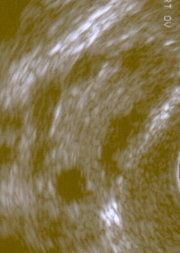BRECKENRIDGE, COLO. -- Hormonal evidence of polycystic ovary syndrome in patients on valproate is often reversed by a switch to one of the newer antiepileptic drugs, Jacci Bainbridge, Pharm.D., reported at a conference on epilepsy syndromes sponsored by the University of Texas at San Antonio.
Women with epilepsy are known to have an increased frequency of polycystic ovary syndrome (PCOS), a common complication of valproate therapy. Evidence that the associated adverse neuroendocrine changes are reversible with a change in seizure medication comes from a recent study by investigators at the University of Birmingham (England), said Dr. Bainbridge of the University of Colorado, Denver.
At the annual meeting of the American Epilepsy Society, the British investigators reported on 16 women with generalized epilepsy who had been taking valproate for longer than 2 years. They ranged in age from 16 to 27 years, and nine had been diagnosed with juvenile myoclonic epilepsy. All patients had the elevated testosterone and/or FSH levels that help define PCOS.
Patients were initially switched from valproate to lamotrigine (Lamictal). If their seizures worsened on the new medication, they were switched again, this time to levetiracetam (Keppra). Eleven women finished the study on lamotrigine. All five patients who were switched to levetiracetam became seizure free. Of the 16 patients, 15 lost hormonal evidence of PCOS during the switch from valproate.
Conference director Jose F. Cavazos, M.D., said that rather than doing routine hormone measurements in his valproate-treated patients in an effort to identify those with hyperandrogenism, he relies upon sudden weight gain as an early clinical tip-off to the presence of PCOS. Weight gain in this setting is often due to the insulin resistance that is one of the first manifestations of PCOS.
There are some data to suggest that there is a dose-dependent relationship between the use of valproate and PCOS. It may be possible to use the drug at lower doses without increasing the risk of the hormonal/metabolic disorder. That's welcome news because valproate remains a useful drug in certain circumstances.
"Patients with refractory primary generalized epilepsy are going to end up on multiple medications--and one of them is often Depakote [valproate]," noted Dr. Cavazos of the University of Texas at San Antonio.
Seizures can entail hypothalamic storm, with resultant long-term adverse effects on the hypothalamic-pituitary-ovarian axis. One outcome can be premature ovarian failure, which is more common in women with epilepsy. This helps explain the relatively low birth rate among women with epilepsy, he said.
Dr. Cavazos mentioned one study in which investigators evaluated 50 consecutive women with epilepsy aged 38-64 years whose seizures began prior to aged 41. A control group included 82 age-matched neurologically normal women. Of the women with epilepsy, 14% had onset of menopause prior to 42 years, compared with just 4% of controls (Epilepsia 2001;42:1584-9).
In another study, Cynthia L. Harden, M.D., of Columbia University, New York, demonstrated that seizure frequency and lifetime number of seizures were associated with earlier age at menopause, according to Dr. Cavazos.
She surveyed 68 women with epilepsy whose mean age at menopause was 47.8 years. The 15 women classified as having a low-seizure-frequency history had a mean age at menopause of 49.9 years, compared with 47.7 years in the intermediate-seizure-frequency group and 46.7 years in the 28 women with high seizure frequency. The age difference was statistically significant.
Potential confounders, including the use of the older enzyme-inducing antiepileptic drugs, smoking history, and number of pregnancies, didn't significantly affect the results (Neurology 2003;61:451-5).
COPYRIGHT 2005 International Medical News Group
COPYRIGHT 2005 Gale Group



